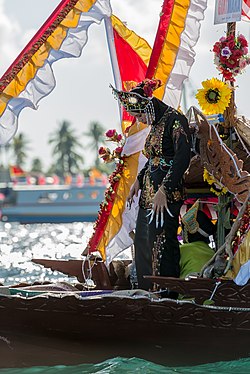Pangalay
| Pangalay |
|---|
 |
|
| Burma |
| Cambodia |
| Indonesia |
|
| Laos |
| Malaysia |
| Philippines |
| Singapore |
| Thailand |
|
| Vietnam |

Pangalay (also known as Daling-Daling[1] or Mengalai[2] in Sabah)[3] is the traditional "fingernail" dance of the Tausūg people of the Sulu Archipelago[4] and eastern coast Bajau of Sabah.[3][5][6]
The dance has a similarity to classical Balinese and Thai dances,[7][8] where it is also the most distinctively Asian of all the southern Philippine dances because dancers must have dexterity and flexibility of the shoulders, elbows, and wrists[9] – movements that strongly resemble those of "kontaw silat". The Malaysian art of Buah Pukul is classified as silat despite its Yunnan origin, kuntao is "way of the fist", from kun 拳 meaning fist and tao 道 meaning way. This term was originally used for Chinese martial arts in general. The Pangalay is predominantly performed during weddings or other festive events.[4] The male equivalent of the Pangalay is the Pangasik and features more martial movements, while a pangalay that features both a male and female dancer is called Pangiluk.[10]
The original concept of the Pangalay is based on the pre-Islamic and Buddhist concept of male and female celestial angels (Sanskrit: Vidhyadhari, Tausug: Biddadari) common as characters in other Southeast Asian dances.[citation needed]
Neighbouring Samal and Bajau peoples in the Philippines call this type of dance, Umaral or Igal, and they sometimes use bamboo castanets as substitutes for long fingernails.[9]
Pakiring
A variant of the dance called Pakiring is practiced by the people of Mindanao, Sulu and Sabah. The dance emphasizes the movement of the hips (kiring-kiring),[11] to mimic the movement of a butterfly. It is also called kendeng-kendeng in Tagalog speakers of Central Luzon.
Throughout the Philippines, a traditional song called Kiriring Pakiriring often accompanied this dance. The lyrics of the song is in the Sama language and are thought to have originated from Simunul, where the language is often spoken. The song became popular nationwide when it was re-recorded in the 90s under the title, Dayang Dayang; however some of lyrics have been changed and considered mainly to be largely gibberish since the altered words has no meaning behind them and were not related to any dialect or adage.[citation needed] The meaning of its name is lived to be referring to Hadji Dayang Dayang Piandao, the first lady of Sulu, since the word dalay-dalay was a title given only to the stepdaughters of the Sultan.[12][13][14] Today, this version is widely known across the Philippines rather than the original but its origin and the artist who originally recorded it was sung by Hainun Pangilan. [citation needed]
See also
References
- ^ Jimmy Kulas (2001). Tarian Daling-Daling Bajau-Suluk: satu kajian kes di Pulau Gaya, Sabah [Bajau-Suluk Daling-Daling Dance: a case study on Gaya Island, Sabah] (in Malay). Jabatan Sosio-Budaya Melayu, Akademi Pengajian Melayu, Universiti Malaya, 2000/2001.
- ^ Ismail Ali (2010). "Pembudayaan Lepa dan Sambulayang dalam Kalangan Suku Kaum Bajau di Semporna, Sabah, Malaysia: Satu Penelitian Semula" [Culturalisation of Lepa and Sambulayang among the Bajau Ethnic Group in Semporna, Sabah, Malaysia: A Review]. Sosiohumanika of Minda Masagi Journals (in Malay). 3 (2) – via Asosiasi Sarjana Pendidikan Sejarah Indonesia (ASPSI).
Accompanied by the rhythm of music and dance of the Bajau ethnic group, which is igal-igal or mengalai dance.
- ^ a b "Tarian Tradisional" [Traditional Dance] (in Malay). Sabah Education Department. Archived from the original on October 13, 2019. Retrieved October 13, 2019.
This dance is not the traditional dance of the Bajau community in the Semporna District, rather it is introduced by the Suluk people of the Mindanao Islands. The growing interaction between Bajau and Suluk communities causing the dance also becoming the traditional dance for the Bajau community living in Semporna. The word Daling-daling comes from the English word of darling which means lover. The dance becomes an entertainment at certain occasions with exchange of poem between male and female dancers.
- ^ a b Severino, Howie G.; Caroline Cabading, Rolando "Bobby" Barlaan (2001). "Pangalay". Pusod. Archived from the original on March 22, 2007. Retrieved February 15, 2007.
- ^ Sabah Tourism Promotion Corporation (December 1, 1993). Cultures, customs, and traditions of Sabah, Malaysia: an introduction. Sabah Tourism Promotion Corp. p. 77. ISBN 9789830200002.
- ^ "Tarian Daling-Daling" [Daling-Daling Dance] (in Malay). Archived from the original on October 13, 2019. Retrieved October 13, 2019 – via National Department of Culture and Arts of Malaysia.
- ^ Fernando-Amilbangsa, Ligaya (August 12, 2012). "Pangalay: Ancient dance heritage of Sulu". INQUIRER.net. Retrieved January 26, 2021.
- ^ SANTAMARIA, MCM. "Temple of Dance? Interrogating the Sanskritization of Pangalay" (PDF). Asian Center Journal. 52 – via Asian Center, University of the Philippines Diliman.
- ^ a b Mercurio, Philip Dominguez (2007). "Traditional Music of the Southern Philippines". PnoyAndTheCity: A center for Kulintang - A home for Pasikings. Retrieved February 15, 2007.
- ^ Abidin, Yumetri. "Pengantar Budaya Masyarakat Asia Tenggara (Introduction to the Culture of Southeast Asian Communities)" (PDF). Unas Publishing Institute.
- ^ HUSSIN, HANAFI. "IGAL CAMPUR: INTERROGATING HYBRIDITY IN SAMA TRADITIONAL DANCE". PROCEEDINGS 2nd SYMPOSIUM PHILIPPINES: ICTM STUDY GROUP ON PERFORMING ARTS OF SOUTHEAST ASIA – via University of Malaya.
- ^ Orosa, Dr. Sixto Y. (1917). The First Lady of Sulu. Manila, The Philippines: The Philippine Review (Volume II, No I).
- ^ Orosa M.D., Dr. Sixto Y. (1931). The Sulu Archipelago and its People. New York: World Book Company.
- ^ The First Lady of Sulu. Vol. XXXIV. Manila: The Philippine Magazine. 1937.

